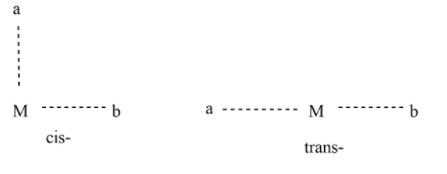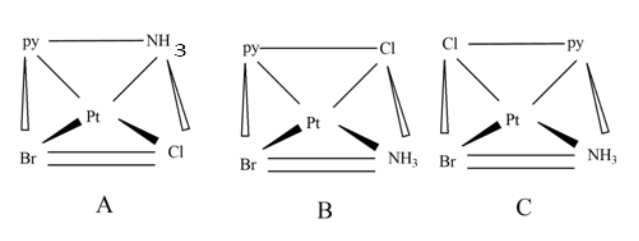
For square planar complex of platinum (II) ,
(A) Two
(B) Three
(C) Four
(D) six
Answer
483.6k+ views
Hint: Coordination compounds can form different isomers. Two main types of isomerism exhibited by coordination compounds are stereo isomerism and structural isomerism. Stereoisomers include both geometric and optical isomers. Structural isomers include linkage, ionization, coordination, and hydrate isomers.
Complete step by step solution:
(1) square planar complexes with formula [MABCD] can form three isomers. These isomers are called “A trans to B”.
(2) square planar complex with formula
Generally, Cis- and trans- refer to the postion of 2 groups relative to each other. In cis- isomer “they are next to each other” , i.e. at 90 degrees in relation to central metal ion, whereas in the trans- isomer they are “opposite to each other”, i.e. 180 degrees relative to the central metal ion.

Where, M=central metal ion , ‘a’ and ‘b’ are ligands.
Given complex,
The above complex is related to a square planar with a type of [MABCD] formula. So, this complex can exhibit three isomers.

A,B, and C are geometric isomers of a given square planar complex. The A isomer is cis isomer named is cis-aminobromo-cis-chloropyridineplatinum(II). Similarly B and C isomers represent trans isomers.
The first report of the three geometric isomers being isolated and characterized of the type [MABCD] in 1928.
From the above geometric isomers, we can give IUPAC names of the isomers separately.
For example, the figure A, the IUPAC name of the isomer is cis-aminobromo-cis-chloropyridineplatinum(II).
Hence , the correct answer is option C = three.
Note: The reactivity and properties of different isomers are often not the same and contribute to applications of coordination compounds. Metal complxes exhibits geometrical isomerism with ligands adject to other is cis-isomer across from another is trans-isomer. Depending upon the property of ligand, structural isomerism exhibits. By using the isomerism of the coordination compounds, can predict their IUPAC names.
Complete step by step solution:
(1) square planar complexes with formula [MABCD] can form three isomers. These isomers are called “A trans to B”.
(2) square planar complex with formula
Generally, Cis- and trans- refer to the postion of 2 groups relative to each other. In cis- isomer “they are next to each other” , i.e. at 90 degrees in relation to central metal ion, whereas in the trans- isomer they are “opposite to each other”, i.e. 180 degrees relative to the central metal ion.

Where, M=central metal ion , ‘a’ and ‘b’ are ligands.
Given complex,
The above complex is related to a square planar with a type of [MABCD] formula. So, this complex can exhibit three isomers.

A,B, and C are geometric isomers of a given square planar complex. The A isomer is cis isomer named is cis-aminobromo-cis-chloropyridineplatinum(II). Similarly B and C isomers represent trans isomers.
The first report of the three geometric isomers being isolated and characterized of the type [MABCD] in 1928.
From the above geometric isomers, we can give IUPAC names of the isomers separately.
For example, the figure A, the IUPAC name of the isomer is cis-aminobromo-cis-chloropyridineplatinum(II).
Hence , the correct answer is option C = three.
Note: The reactivity and properties of different isomers are often not the same and contribute to applications of coordination compounds. Metal complxes exhibits geometrical isomerism with ligands adject to other is cis-isomer across from another is trans-isomer. Depending upon the property of ligand, structural isomerism exhibits. By using the isomerism of the coordination compounds, can predict their IUPAC names.
Recently Updated Pages
What is the tent of the Changpa tribe called A Rebo class 7 social science CBSE

Who is the President of India class 7 social science CBSE

In the given figure SRparallel QP and angle RPQ 30 class 7 maths CBSE

Describe Baburs conquest of Punjab class 7 social science CBSE

Who is incharge of all the police stations in a di class 7 social science CBSE

Fill in the blanks Every number is a multiple of class 7 maths CBSE

Trending doubts
State and prove Bernoullis theorem class 11 physics CBSE

What are Quantum numbers Explain the quantum number class 11 chemistry CBSE

Write the differences between monocot plants and dicot class 11 biology CBSE

Who built the Grand Trunk Road AChandragupta Maurya class 11 social science CBSE

1 ton equals to A 100 kg B 1000 kg C 10 kg D 10000 class 11 physics CBSE

State the laws of reflection of light




